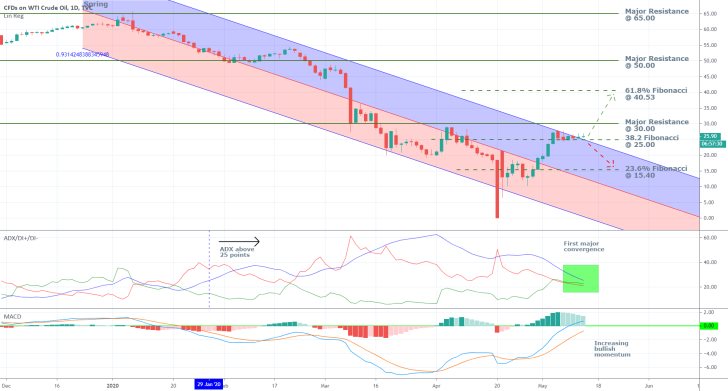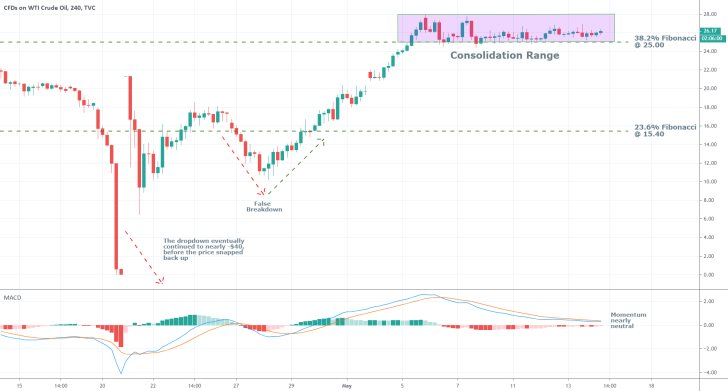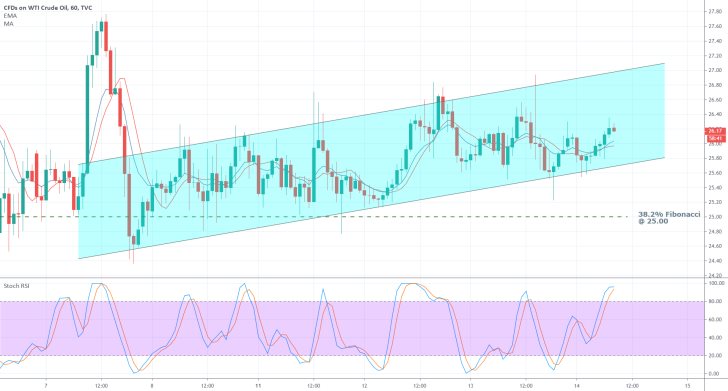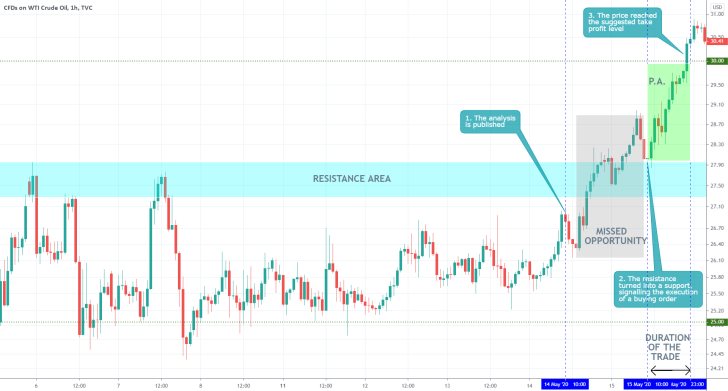The price of crude oil, especially that of the West Texas Intermediate (WTI) type, has been quite volatile over the last several weeks. The massive tribulations that the precious commodity has experienced are summarised for you in our latest Global Affairs material.
The WTI tumbled to nearly -$40 per barrel when the May futures contracts expired in late April, but has subsequently managed to bounce back to around $25 per barrel. Following this momentary 'stabilisation', the price of crude has started to consolidate within the boundaries of a narrow range, as investors wait to see whether global demand would pick up now that more and more states are working towards gradually reopening their economies.
Most traders are weighing in on whether the price would break out above the consolidation range, thereby forming a new bullish trend signifying the further normalisation of the energy market. In contrast, others are concerned with the possibility of the aggregate supply still outpacing the moderate rise in global demand, leading to a new selloff near the $0 threshold.
That is why today's analysis evaluates the most recent accords struck by OPEC+ as regards cutting oil production even more and examines how these changes to global supply are likely going to affect crude's price in the midterm. The analysis also studies the overall behaviour of the underlying price action that has been observed recently.
1. Long Term Outlook:
As can be seen on the daily chart below, the price action currently finds itself at a crucial junction, with the possibility of heading in either direction. As regards the ADX, the index has been trading above 25 points since Late-January, which means that the market currently finds itself in a trending environment.
Nevertheless, the ADX is very close to falling below this pivotal benchmark, which would underpin the transition of the market into a technical range-trading environment. This would be bad news for the market bulls, as it would also signify the exhaustion of the recent bullish correction's strength, and would also make the change of the price action's underlying direction seem more likely.
Additionally, the ADX is currently in the process of converging towards the DI+ and the DI-, as highlighted by the green square on the chart below. This behaviour underlines the momentary balancing of the underlying market pressures and is commonly associated with potential formations of new directional swings in either direction. Hence, a new massive breakout or breakdown could be anticipated to emerge shortly.

The MACD is demonstrating moderately rising bullish momentum, but it is also nearing a crucial turning point – the 0.00 level. As it is well-known, such levels have psychological importance in the market, as they can prompt traders to act on them as the market nears them. Consequently, it is not uncommon for the underlying equilibrium between the buying and selling pressures to be distorted around such level, thereby changing the direction of the price action. Overall, it seems that both the MACD and the RSI indicate the very probable formation of a new substantial breakout or breakdown out of the current range's boundaries in the near term.
To top it all off, the price action is consolidating just above the 38.2 per cent Fibonacci retracement level at 25.00 and below the major resistance level at 30.00. This narrow range currently coincides with the downwards sloping channel's upper boundary, which further underscores the major crossroads that the underlying price action finds itself on.
If the short term bullish momentum manages to persist, thereby driving a new breakout of the price above the major resistance level at 30.00, the next likely target for the newly forming bullish trend would be the 61.8 per cent Fibonacci retracement level at 40.53. Conversely, a rebound from the channel's upper edge would indicate the likely formation of a new bearish downswing, which could fall as low as the 23.6 per cent Fibonacci retracement level at 15.40 before it finds support.
2. Production Cuts Likely to Affect Aggregate Supply Shortly:
Recently, Saudi Arabia announced new rounds of oil production cuts, and its decision has been ratified by other members of OPEC+ as well. Overall, the organisation has agreed to reduce its aggregate production by over 1.2 million barrels per day, which is in addition to the nearly 10 million barrels, which were already agreed-upon during the organisation's previous meeting.
The market has so far been slow to react to such developments in the past, which means that several more days may have to pass before the market starts pricing in the aggregate supply reductions. However, these cuts are very likely further to bolster the underlying bullish momentum in the market. Consequently, this makes the formation of a new breakout above the aforementioned range's upper limit seem more likely than the establishment of a new breakdown.
3. Short Term Outlook:

As can be seen on the 4H chart above, the underlying momentum in the short run is currently indecisive, which means that it could proceed in either direction. Meanwhile, the price action is indeed consolidating within an extremely narrow range, just above the 23.6 per cent Fibonacci retracement level at 25.00.
The prevailing indications favour the continuation of the broader bullish trend's development further north; however, this does not preclude the possibility for the emergence of short-term fluctuations to or below that level. False breakdowns are likely to form due to the likely execution of multiple short orders around the upper boundary of the aforementioned downwards sloping channel.
The hourly chart below reveals the existence of a minor ascending channel in the very short term. Any decisive breakout or breakdown outside its boundaries would likely provide traders with the first major indication highlighting the emergence of the highly anticipated new directional swing.
While the price action remains contained within the boundaries of the channel, however, range-trading strategies can be implemented utilising the Stochastic RSI's swift changes.

4. Concluding Remarks:
Overall, the price of crude oil is set to form a new major trend in either direction. The underlying fundamentals seem to favour the emergence of a new bullish trend, given the recent decision of OPEC+ members to increase the scope of their production cuts further.
At any rate, the transition of the underlying market environment from its current range-trading state to having a distinctly trending outlook is likely to be marked by rising sporadic price action. Hence, the very likely formation of false breakouts and false breakdowns is to be anticipated by traders.

- The analysis demonstrated a perfect trend-continuation trade, however, it missed the beginning of the new markup. The above scenario demonstrates the importance of corrections during the emergence of a new trend. Chiefly, the opportunity to buy into an uptrend at the lower end of a bearish correction, or to sell into a downtrend at the peak of a bullish correction.
Disclaimer: Your capital is at risk! Trading and investing on the financial markets carries a significant risk of loss. Each material, shown on this website, is provided for educational purposes only. A perfect, 100% accurate method of analysis does not exist. If you make a decision to trade or invest, based on the information from this website, you will be doing it at your own risk. Under no circumstances is Trendsharks responsible for any capital losses or damages you might suffer, while using the company’s products and services. For more information read our Terms & Conditions and Risk Disclaimer.





















